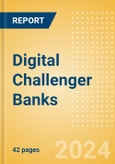Digital-only banks have become commonplace across the world, offering a digital-first approach to banking that focuses on an improved customer experience. Historically, these banks have focused on customer acquisition at all costs, placing doubt on their ability to turn a profit in the long run. However, the tide seems to be changing, with a number of the neobanks examined in this report seeing their first glimpse of profitability. This review focuses on some of the most interesting neobanks (including Monzo, Revolut, Nubank, and KakaoBank) and covers a range of categories, such as financial performance, product offering, and funding. It also examines two notable neobank failures and what other challengers can do to avoid such a fate.
2023 saw a remarkable transformation in the fortunes of digital challenger banks, particularly in the context of surging interest rates driven by global efforts to tackle inflation through monetary policy. In our preceding report, Digital Challenger Banks: The Quest for Profitability, many neobanks were still on the journey towards generating a profit. However, a notable shift unfolded in 2023, with a significant majority of digital players not only anticipating but also realizing a full year of profit. This trend was largely propelled by a substantial increase in net interest income. The shift underscores a pivotal turning point for digital challengers, marking their increasing financial sustainability and resilience in an ever-evolving market landscape.
2023 saw a remarkable transformation in the fortunes of digital challenger banks, particularly in the context of surging interest rates driven by global efforts to tackle inflation through monetary policy. In our preceding report, Digital Challenger Banks: The Quest for Profitability, many neobanks were still on the journey towards generating a profit. However, a notable shift unfolded in 2023, with a significant majority of digital players not only anticipating but also realizing a full year of profit. This trend was largely propelled by a substantial increase in net interest income. The shift underscores a pivotal turning point for digital challengers, marking their increasing financial sustainability and resilience in an ever-evolving market landscape.
Scope
- Traditional banks and neobanks alike have reaped the benefits of increased interest rates. Neobanks with lending products have experienced a stark increase in net interest income. However, rates are expected to begin falling in 2024, so neobanks will need to acquire more customers to generate similar revenues.
- Neobanks face a crucial opportunity to strategically allocate profits from this prosperous period. With the upcoming decline in interest rates, it is imperative for them to wisely invest in expanding lending portfolios and acquiring income-generating assets such as treasuries. This proactive approach is essential for neobanks to not only sustain but enhance their profitability, showcasing strategic foresight in the evolving financial landscape.
- Successful neobanks have begun exploring new revenue streams, such as launching investment and cryptocurrency trading products, premium accounts for the mass affluent, and even white labeling their in-house software.
Reasons to Buy
- Identify some of the strongly performing digital banks across the world.
- Learn about the key factors that are essential to building a successful neobank.
- Discover why neobanks fail and what they can do to avoid it.
Table of Contents
1. Executive Summary
2. The Global Digital Challenger Bank Market
3. The UK
4. The European Economic Area
5. Americas
6. Asia-Pacific
7. Neobank Failures
8. Appendix
List of Figures
Companies Mentioned (Partial List)
A selection of companies mentioned in this report includes, but is not limited to:
- Monzo
- Starling Bank
- Xinja
- ZA Bank
- GXS Bank
- GXBank
- Nubank
- Chase UK
- Revolut
- bunq
- N26
- Chime
- Trust Bank
- KakaoBank
- Alex Bank
- Orange Bank








